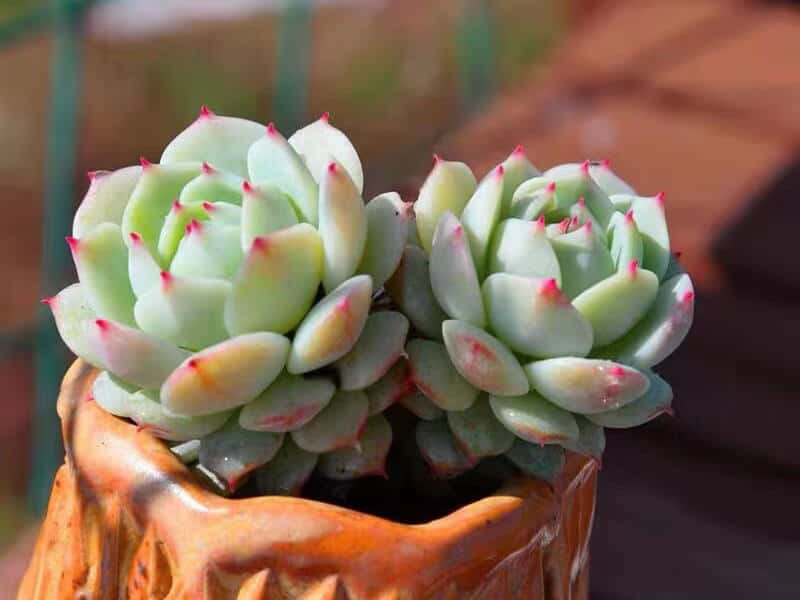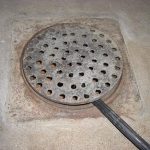Among the stone-crop family of succulents, the painted lady is a native of Mexico. It has blue-gray leaves with red borders and grows slowly in a rosette. It also readily generates offsets. Late winter to early spring will see cup-shaped flowers that are yellow with red tips.
This succulent is frequently grown indoors and performs finest in well-drained potting soil with full to partial sun. It may be cultivated in rock and crevice gardens in warm climates.
Echeveria Derenbergii ‘Painted Lady’ Care
E. derenbergii typically produces a large colony of tiny rosettes that spread widely, forming a blanket of blue-gray plants. Eventually, they’ll likely all bloom at once, with attractive arching stems of pink and gold blossoms. These plants, which are Mexican in origin, thrive in environments with similar lighting, drainage, and absence of cold temperatures. There is no reason why Echeveria derenbergii can’t flourish if you can also grow other Echeveria.
Sunlight
Echeveria species have adapted to a warm, sunny environment after flourishing naturally in warm areas. The species and the several exquisite Echeveria hybrids generated from them call for the same level of maintenance. Even while Echeveria like bright light, placing them in the sun’s direct rays during the summer can stress them out and result in burns. Please put them in a spot that only receives rising sun for a couple of hours each day, then gradually increases it over a week or so until they are in full sun. Avoid any afternoon sun at all costs, as the plant will become stressed, and the foliage may scorch. The brightest window you can provide will do just well in the winter, or you can grow them under fluorescent grow lights on a twelve to fourteen-hour cycle.
Soil
Echeveria requires particularly well-drained soil because root rot can result from too much moisture in the soil’s lower layers. Use a sterilized potting mix and add at least half turkey grit, other small gravel, or pumice without adding any additional fertilizer. Echeveria dislikes alkaline soil, as some growers have learned, but this is usually not a problem, except your water is also quite alkaline. In this situation, save your rainwater for water plants since it benefits them.
Water
Water depends on the temperature, as Echeveria will use far less water when it’s cool or raining and significantly more during the height of summer. Rainwater collected from a roof is ideal since it lacks minerals that could damage the blooming or pruinose on the leaves of Echeveria and other succulent plants.
Temperature and Humidity
Echeveria can withstand a wide range of temperatures, yet many types and species can be found. Most Echeveria and other succulent plants thrive in dry, warm weather and prefer a temperature variation of roughly 10 degrees daily and night. Many people in winter are quite satisfied with the chilly temperatures, which can reach as low as 4-6 degrees Celsius at night and as high as 15 degrees Celsius in the daytime. They can tolerate relatively high temperatures in the summer, particularly in a greenhouse setting. However, if the temperature is beyond 30 degrees Celsius, it is ideal if they have some shade. Most plants cease breathing when the temperature rises above 30 degrees, but they resume breathing after dusk falls and the temperature drops.
Fertilizer
Echeveria rarely needs fertilizer. Use a water-based fertilizer less frequently, and at a concentration of roughly half of your plant appears a touch pale and listless. Worm castings spread on top of the soil provide all the nutrients plants require, releasing them gradually over months and never burning. The steep learning curve required for cultivating Echeveria makes it difficult at first. Still, once you get the hang of it, you’ll have happy, blooming Echeveria gracing every windowsill on your balcony or deck in the summer with considerably less watering required.
Using a strong, highly concentrated fertilizer can be detrimental to your succulent therefore it is advised to use a diluted one.

Propagate
Beheading the plant and starting a new one with the damaged leaves removed is the best action if the foliage becomes burnt. The leaves may be used for replication if they have not sustained too much harm.
Pests and Plants Diseases
Plant Diseases
Echeveria Derenbergii is nearly disease-free if not overwatered. Your plants may experience leaf, root, and other fungal-type diseases if they are overwatered.
Pests Diseases
Vegetation pests like mealybugs, vine weevils, and aphids can attack already weak plants.
A patio or container plant, as well as a window garden succulent houseplant, is the Derenbergii Painted Lady Echeveria. If kept as a decorative plant, it will benefit from being kept outside in the spring and summer in bright light. The Echeveria Derenbergii Painted Lady, like all Echeverias, is a fantastic option for xeriscaping, rock gardens, and other low-water environments.



